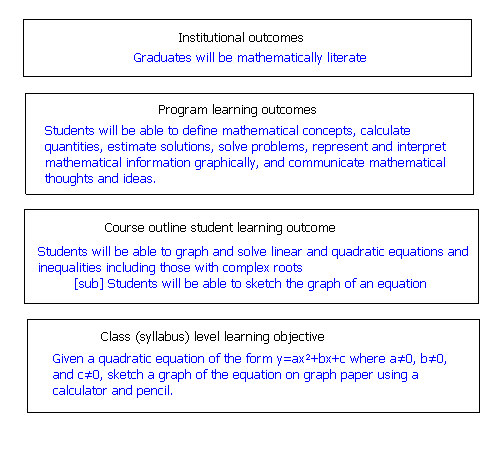
The following is a response to attempt to clarify the difference between an outline and a syllabus. At issue was a syllabus, confused for a proposed outline format, that tracked each and every students performance on 84 learning outcomes in a prealgebra class.
My apologies, I have confused everyone. This is NOT a new format for OUTLINES, which is what I perceive the ESS chair has taken it to be. As for the format of outlines, we have long noted that somewhat different formats best serve education, vocational education, and other academic disciplines. My own perception is that the math science division, social science division, and lang lit division have a fairly comparable outline style.
There is no intent to introduce a new style, unless the
MS
100 draft is thought to be a new style. The structure is
program-course-specific student learning outcomes, the same three part
structure I described in 2002 in the document at:
http://www.comfsm.fm/~dleeling/department/ms150sidebyside.html
This "three tier" format has been used by this division since that
time. That format did not include a content section, but our outlines
did have such a section in the 1990s. As I said, if this section is
deemed necessary,
I
will include it.
What the math instructor is working on is his syllabus. He is working on tracking exactly what each student can do and when they have mastered that skill. He has 84 specific skills in the syllabus, if he were to have 60 students and a grid of ten encounters with the concept, then that is what generates the large number. His plan is track each student against each and every outcome, with multiple encounters against any given outcome. This will permit him to say exactly how Billy is doing, where Sally is weak, etc. He will also be able to aggregate this to determine class wide weaknesses on specific outcomes.
I think this is right on target at the class level - IF one can handle the data load. I asserted back in 2002 that the data load was unreasonable for many of our classes. I did use this approach in the joggling class. Each time a student demonstrated competency in a specific student learning outcome I recorded the date as a check-off that the skill was exhibited. The class was, however, very small, and the number of outcomes was relatively small.
~~~My own vision is that the course outline should be somewhat generic and broad. The instructor then builds, not every single term but once for each course, their own more granular and micro-specific outcomes that effectively become - pardon the archaic term - the behavorial objectives for a given lesson. I will try to depict this in a diagram:

Please do not assault me: I made up the institutional level outcome. The middle two are "real", the program learning outcome exists and is approved, the course outline learning outcome is on the proposed MS 100 outline. The last level is that which I used in my class this past summer, this is the level of the document that the math instructor was working upon. It is that last level that is most easily directly assessable.
My thanks to the math instructor and the ESS chair who both always challenge me to clarify my muddy and confused thinking. My ineptness as a writer is a well known quantity. My fifth grade teacher who declared that I would never be able write, let alone write with any clarity, passed away this past summer.